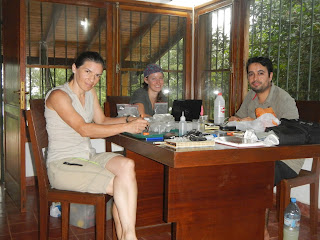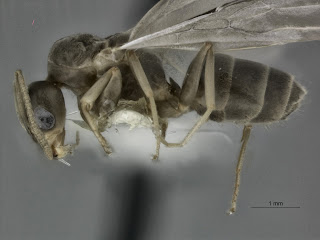An old association: ants & orchids
The Cretaceous period was a time during which not only ants diversified but also Angiosperms and in particular orchids (Wilson and Hölldobler 2005, Lubisnsky et al 2008). Nowadays, the number of orchid species is estimated in almost 35.000 species meanwhile ant species reached the modest number of 15.916 (Cribb et al 2003, www.antweb.org visited in August 2015).The Pantropical genus Vanilla Plumier ex Miller, is a group of orchid with about 107 species (Lubisnsky et al 2008). An interaction exists between Vanilla and ants, as also demonstrated for other orchid species (Gigant et al 2011). Extrafloral nectar is produced in many Vanilla sp and ants were observed collecting this sugary exudate.
So, this year I expanded my research interests from the interaction between ants and honeydew producing insects to the interaction between ants and extrafloral nectarium (EN). As a consequence, I proposed to my colleagues, Priscila Hanisch and Andrés Sánchez Restrepo, to join me in a new project at rain forest of Osununu, Misiones (Figure 1) concerning the association between the orchid vine Vainilla chamissonis Klotzsch and nectivorous ants.
Figure 1. From left to right Andrés, Priscila and me preparing to climb one of the trees where there is attached a vine of V. chamissonis. At the top of the plant, 5 m above, there some flowers where we have seen same patrolling ants.
Our main goal is to identify which ant species collect nectar from the EN of the V. chamissonis and to investigate if they perform some ecological service i.e defend this orchid against herbivores. In particular, we chose this orchid because it is an endangered species in Argentina. Apparently this situation is a consequence of the combination of two factors. The first one is the particular soil requirements this orchid vine has. This orchid is usually found in well drainage soils like sandy soils or very organic soils. For example in Brazil its distribution comprises the Atlantic coast restingas (Reis et al 2011). In Argentina, up to know it have been identified sparse populations in only two small areas at Misiones, Chaco and Formosa provinces, close to river areas. The second factor of the rarity of V. chamissonis, is the reduction of its natural habitat combined with human exploitation.These are the most common threats for orchids plus climate change (Swarts and Dixon 2009).
In our first field campaign, we found Camponotus mus (Figure 2) and Pseudomyrmex gracilis collecting nectar on the only two plants that produced flowers. These ant species are very generalist and collect sugar solution from many sources in the area we surveyed (Figure 3). We don´t expect a very close association with this orchid.
Figure 2.The extrafloral nectaries in the case of V. chamissonis are at the base of the flowers.
Figure 3. From top right to left bottom, in this collage Dyckia distachya Hassler an endangered species of Bromeliaceae according to Zanella et al (2012) provides small drops of extrafloral nectar from an inconspicuous nectarium to a C. mus worker. The mayor worker is patiently waiting that the minor finish leaking the drop.

well for Andres who collected some samples of Attine group.


Figure 4. We sampled ants using pitfalls (Andres at top), winklers (Andres and Priscila hanging them in the center), shifting litter and doing hand collection (Caro at bottom).
Thanks to Temaiken Fundation (www.temaiken.org) for supporting our work and allowing us to work in a wonderful place (Figure 5).
Figure 5. There are nice views in this area but, as in every rain forest, often rains.That is the time to sort material and to organize everything for a secure transportation.
References
Cribb PJ, Kell SP, Dixon KW, Barrett RL, 2003. Orchid
conservation: a global perspective. In: Dixon KW, Kell SP, Barrett RL, Cribb
PJ, editors. Orchid conservation. Kota Kinabalu, Sabah: Natural History
Publications; pp. 1–24.
GigantRodolphe, BorySéverine, Grisoni Michel, Besse
Pascale, 2011. Biodiversity and Evolution in the Vanilla Genus, The Dynamical
Processes of Biodiversity - Case Studies of Evolution and Spatial Distribution,
PhD. Oscar Grillo (Ed.), ISBN: 978-953-307-772-7, InTech, Available from:
http://www.intechopen.com/books/the-dynamical-processes-of-biodiversity-case-studies-of-evolution-andspatial-
distribution/biodiversity-and-evolution-in-the-vanilla-genus.
Lubinsky P, Cameron K M, Molina M C, Wong M,Lepers-Andrzejewski
S, Gómez-Pompa A, Seung-Chul K, 2008. Neotropical roots of a Polynesian spice:
the hybrid origin of Tahitian vanilla, Vanilla
tahitensis (Orchidaceae). American Journal of Botany, 95 (8): 1040-1047.
Reis
CAM, Brondani GE, de Almeida M, 2011.Biologia floral,
reprodutiva e propagação vegetativa de baunilha. ScientiaAgraria Paranaenis10: 69-82.
Swarts N D, Dixon K W, 2009.Terrestrial orchid
conservation in the age of extinction.Annals of Botany 104: 543–556.
Wilson E, Hölldobler B, 2005. The rise of the ants: A
phylogenetic andecological explanation. PNAS 102 (21): 7411–7414.
Zanella C, Janke A, Paggi G, Goetze M, Reis
M, Bered F, 2012. Microsatellites in the endangered
species Dyckia distachya (Bromeliaceae) and cross-amplification in
other bromeliads. Int J Mol Sci. 13(12): 15859–15866.





































